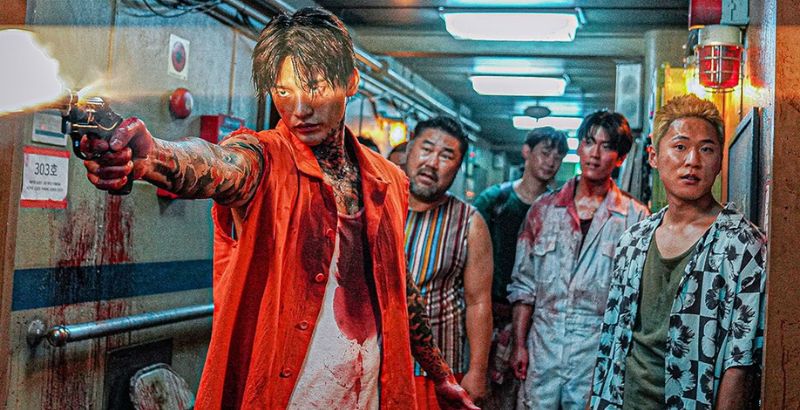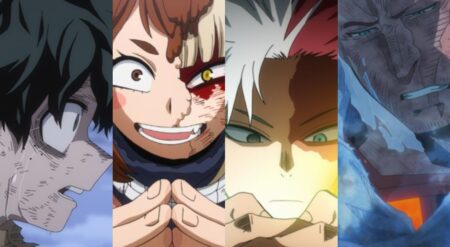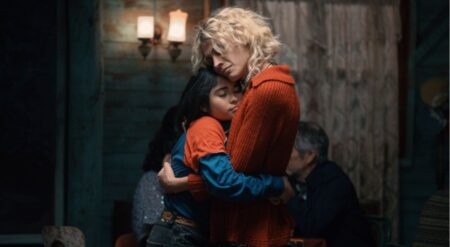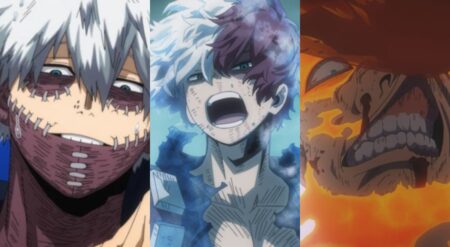
This interview contains spoilers for Project Wolf Hunting
I got the chance to watch Project Wolf Hunting at Fantastic Fest 2022 and it was the best experience in a theater I’ve had this year. Packed with action, gore, science fiction, and more, this is one to watch. Directed and written by Kim Hong-sun, Project Wolf Hunting film is a horror-thriller-crime-science fiction blood bath all set on a boat. A cross between CONAIR, Overlord, and even Capcom’s Resident evil, this gnarly action film redefines high octane and bloody at the same time.
When efforts to extradite notorious convicts from the Philippines to South Korea are stymied by a deadly airport bombing, the Korean authorities commandeer the cargo freighter, Frontier Wolf, for their next transfer. As a rogues’ gallery of lowlifes, including a callous heir to a criminal empire (Seo In-Guk), board the titanic vessel, they are escorted by two dozen hardened detectives and the vigilant oversight of a hot-headed Coast Guard captain (Sung Dong-il). Despite the heavy security, a plot to seize control of the ship percolates among the prisoners and soon boils over, but they are the only thing being transported on the ship. What starts as a hijacking crime thriller changes into a brutal science fiction slasher as a sinister shape (Choi Guyhwa) emerges from the bowels of the ship, indiscriminately hunting its passengers. With buckets of blood painting the ship over the film’s runtime.
I got the chance to sit down with Kim Hong-sun about the film’s inspiration, the genre-blending violence, and of course the kills.
BUT WHY THO: I got the chance to watch Project Wolf Hunting last week and it was fantastic. I have to ask, what were some of your inspirations for blending various genres in the film and how did you decide to blend them together?
KIM HONG-SUN: There are already a lot of action thrillers out there. The audience is almost fed up, and if I had made this film as a simple crime action, it would have just been one of many. Also cinema directors have to compete a lot with OTT, streaming services, and people don’t have to come to the theater to watch movies. So in order to attract audiences to the theater I had to think more and add something to the simple genre. It’s not just like Conair, I wanted to do more than that.
So I started searching, since I enjoy reading newspapers and social stories and histories. I read about what happened during WWII to the victims who were experimented on by the Nazis and the Japanese, so I wanted to add that in. But I didn’t want to exploit them commercially because these are also sad stories. I wanted to add some changes through genre, and to keep it from being too depressing I added the third genre: science fiction. I wanted to be able to remind the audience “This is a film, it didn’t really happen. Please don’t be sad.”
BUT WHY THO: I had the option for a digital screener or to go watch it in the theater, and I chose the theater. It was the loudest and most excited crowd I’ve had all year so it was a true experience.
KIM HONG-SUN: You have to go to the theater for this, it’s much better.
BUT WHY THO: It was phenomenal and I think part of that is because it was the most blood I’ve seen on screen in a long time. And that’s my next question. how did you all manage to craft the scenes that kept the actors’ faces and clean visuals while they were still covered in so much blood? It was a great balance I would love to know the process behind that.
KIM HONG-SUN: [Director Kim laughs] Except for Jong-du, you can still see all of the actors faces even though they die off one by one. The reason my actors said yes to my film is that they understood that their entrance and their exit would be defined very clearly. Yes, they were bloody but I tried not to obscure their faces or their eyes. When I speak of Jung-du, yes he’s the only character whose face is cut off by this hammer, and I feel sorry for that.
Yet, it has to be done because he is the catalyst between the two genres. Because of his demise, we move from one genre to the next. For the other actors though, we worked really hard and put our heads other to make sure that we keep their faces recognizable even though they were about to die.
BUT WHY THO: I like that you brought but Jong-du because I really love Seo In-guk. I wanted to know, there is no plot armor at all and everyone is on the chopping block to get killed. Were you hesitant at all in that with some of the actors who have really large fan bases? Were you worried or was it always going to happen from the start?
KIM HONG-SUN: What’s more important for me is storytelling. So long as the story is plausible that she or he can’t help but die, it has to happen. Even if you try to hide somewhere, Alpha will find you. It’s more realistic for everyone to die. Now, in Seo In-guk’s case, I know he has very avid fans and they probably hate that he has to die, or on Naver they may try to trash the film, but for me it’s all about narrative. And remember Jang Dong-yoon who plays Do Il is alive. [Director Kim laughs] Okay, I realize because of the fanbase I should have saved Seo In-guk’s character.
BUT WHY THO: I have to say, he has the best death out of everyone and you were able to make me hate him up until that point even though I love Seo In-guk, so it was perfect, you succeeded.
KIM HONG-SUN: Thank you very much!

BUT WHY THO: My next question is about the shooting in such a confined location. There are a lot of hallways and small rooms, specifically the engine room. What are some of the strengths or difficulties that went into shooting in such cramped spaces?
KIM HONG-SUN: The strength of shooting in a confined space, and the narrowness increases the intensity. It also helped me make the film more real, a more heightened reality. But I also prioritized with my actors and crew that their safety was the most important. So I used an actual ship but I also was able to shoot on a set. But even if it was a set it was built to be as close as it can to a real ship which means that it has a lot of sharp materials and steel, so they could have been injured. I always told my crew and actors not to hurry and to always slow down. We always made sure to have a lot of rehearsals to reduce the chance of accidents and after shooting over six months, no one got injured.
BUT WHY THO: What was your favorite scene to film or coach actors through? What scene sticks with you the most?
KIM HONG-SUN: As you know, this film has an ensemble cast so the actors stayed together in a dormitory setting. It’s hard for me to choose my favorite scene but if I have to choose something for me in this movie, each one dies and those scenes are the most memorable for me. Since you told me you are a big fan of Seo In-guk, let me tell you a little bit about his death scene. When he dies, he yells out “FUUUCK!” I mean, he’s a singer, but he didn’t care about losing his voice while screaming so loudly. He should have been concerned about losing his voice but he wasn’t. He poured everything he had to shoot this scene. Unfortunately, we had a technical issue when we shot that scene. I had to tell him that we needed to do it again and he was fine with that. And this is one of the memorable scenes because of his devotion to doing this scene the right way.
BUT WHY THO: My last question is, what do you want people to feel or think the moment that the credits roll?
KIM HONG-SUN: This is a commercial affair for as many people as we can get. I want them to think that Project Wolf Hunting was dynamic, exciting, fresh and lots of fun. I want them to think about my movie all day long and perhaps into the next day, talk to other audience members and people about it. That’s my hope.
Project Wolf Hunting screened at the Toronto International Film Festival, Fantastic Fest, and Beyond Fest this month and is being distributed in the United States by WellGOUSA.





![[EXCLUSIVE] ‘Invincible VS’ Devs Dive Deep Into Their New Original Character: Ella Mental Ella Mental in Invincible VS](https://butwhytho.net/wp-content/uploads/2025/12/Invincible-VS-Ella-Mental-But-Why-Tho-1-450x247.jpg)
![[EXCLUSIVE] Palia Devs Dive Into Winterlights, New Tints, Lunar Paths, And More From Upcoming Patch Palia Winterlights Patch](https://butwhytho.net/wp-content/uploads/2025/12/Palia-Winterlights-But-Why-Tho-450x247.jpg)